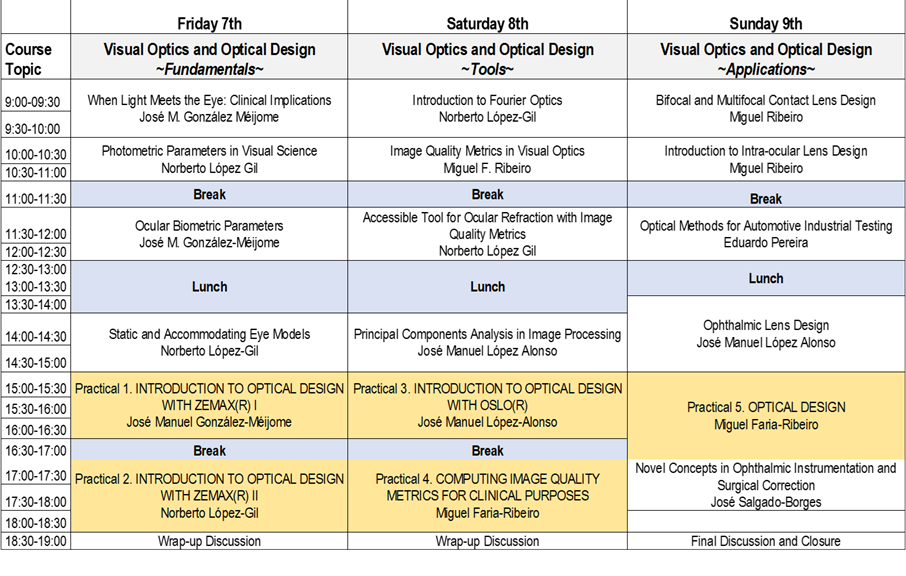
Óptica Visual e Desenho Óptico

Learning outcomes of the course:
At the end of the course, students should be able to:
- Understand the physical nature of light, the optical singularities of the different structures of the human eye and their contribution to the final quality of the retinal image.
- Understand the physical principles of modern wavefront aberrometers like the Shack-Hartmann wavefront aberrometer and use them to obtain a comprehensive description of the optical aberrations of the eye.
- Develop optical models of the human eye and use them as a tool to study the optical performance of devices such as ophthalmic, contact or intraocular lenses.
- Apply optical modeling techniques to predict the average optical / image quality performance of a population or an individual.
- Use computational tools, such as Zemax and Matlab optical design software, to infer visual function from structure, based on the topographical and morphological characteristics of the different elements of the eye.
- Use and understand the classical methods used in physical optics to classify image quality of an optical system, such as modulation and phase transfer functions, point spread function, optical path differences, Strehl ratio and others.
The acquired knowledge will serve as basis for understanding the fundamental principles of visual optics and optical design of complex ophthalmic elements, such as multifocal contact lenses and diffractive intraocular lenses to correct presbyopia.
Syllabus:
- Light and matter interaction
- Propagation, Absorption and Transmittance
- Radiometric and Photometric Measures
- Fundamentals in Visual Optics
- Refractive and Dimensional Properties
- Reference Axis and Angles
- Conventions in Visual Optics
- Image Formation
- Optical Principles in Visual and Ophthalmic Optics
- Aberrations
- Diffraction
- Interference
- Scattering
- Ophthalmic Instrumentation
- Refractive Measurement
- Image Quality
- Dimensional Measurements
- Designing optical system for vision research
- Safety standards for vision research
- Simple optical set-ups for vision research
- Ocular wavefront sensors
- Theoretical-practical classes
- Computational work I (refracting artificial eyes and image quality metrics)
- Computational work II (optical design)
- Computational work III (optical quality assessment)
- Computational work IV
- Practical work
- Wavefront measurement and refraction
- Image quality analysis in experimental eye models
- Building and aligning optical systems
- Ocular biometric measures
General books and papers:
- HECHT, Eugene. Optics. Pearson Education, 2016.
- GOODMAN, Joseph. Introduction to Fourier optics. 2008.
- ATCHISON, David A.; SMITH, George; SMITH, George. Optics of the human eye. 2000.
- DAI, Guang-ming. Wavefront optics for vision correction. Bellingham: SPIE press, 2008.
- GUIRAO, Antonio, et al. A method to predict refractive errors from wave aberration data. Optometry and Vision Science, 2003, 80.1: 36-42.
- CHENG, Xu; THIBOS, Larry N.; BRADLEY, Arthur. Estimating visual quality from wavefront aberration measurements. Journal of Refractive Surgery, 2003, 19.5: S579-S584.
- THIBOS, Larry N., et al. Accuracy and precision of objective refraction from wavefront aberrations. Journal of vision, 2004, 4.4: 9-9.
- CHENG, Xu; BRADLEY, Arthur; THIBOS, Larry N. Predicting subjective judgment of best focus with objective image quality metrics. Journal of Vision, 2004, 4.4: 7-7.
- APPLEGATE, Raymond A.; MARSACK, Jason D.; THIBOS, Larry N. Metrics of retinal image quality predict visual performance in eyes with 20/17 or better visual acuity. Optometry and vision science: official publication of the American Academy of Optometry, 2006, 83.9: 635.
- NAVARRO, Rafael. Refractive error sensing from wavefront slopes. Journal of vision, 2010, 10.13: 3-3.
- FARIA-RIBEIRO, Miguel; NAVARRO, Rafael; GONZÁLEZ-MÉIJOME, José Manuel. Effect of pupil size on wavefront refraction during orthokeratology. Optometry and Vision Science, 2016, 93.11: 1399-1408.
- GOBBI, Pier Giorgio. Modeling the Optical and Visual Performance of the Human Eye. Spie Press Book. 2010.
- ARTAL, Pablo. Handbook of visual Optics, Volume I & Volume II. CRC Press. 2017.
